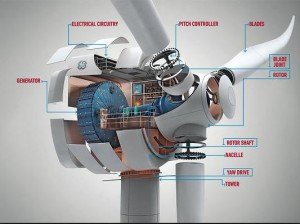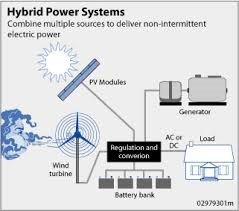
Wind Energy System Components
1. Turbine support or tower
A tower is usually composed of tubular steel or perhaps steel lattice. Wind turbines are typically mounted on tall towers to catch the optimum energy since the wind speed is more powerful and less turbulent at higher locations. Turbines can be attached to roofs or on supports that are bracketed to the home for support. If there is space for a separate tower a latticework tower is the most durable.

Wind Turbine
2. Turbine Blades
A majority of turbines have two or perhaps three blades. Every blade is like the wing of an airplane. A pocket of low-pressure air accumulates in the downwind side such blades every time the wind blows. The low-pressure air pocket would then pull the blade towards it which causes the rotor to turn. This is known as lift. The lift’s force is much stronger than the force of the wind against the front side of the blade, which is referred to as drag. In most small scale wind systems the rotor is attached directly to the shaft of the alternator and the power output is converted to direct current or D/C. Power is then grid tied through the use of a power modulating inverter. In large systems the blade is attached to a shaft which is then connected to gears in order to increase the rotations per minute or RPMs. The gears then turn a shaft that connects to an electrical generator.
3. Rotor
A rotor sits underneath the turbine and is attached to the shaft of the tower or support and allows the blade and turbine system to rotate with the changing direction of the wind. A tail is usually attached to the turbine design to guide the turbine into the wind and keep the blades rotating at maximum speed.
4. Generator
Generators or alternators convert the mechanical energy from the turbine into electrical energy through the use of permanent magnets which create a current after being rotated at high speeds. They produce an alternating or A/C current which is used in households to power electric appliances.
5. Governor
A governor or controller is needed to moderate the speed of the turbine. Controllers turn on the turbine at wind speeds of between 8 and 16 miles/hour and turn it off at around 65 miles/hour. The machines are not able to work at wind speeds that go beyond 65 miles/hour since the generators are likely to overheat. A shutdown mechanism is also useful to stop the machine when necessary, such as during an extreme storm, when you do not need the energy, or when you want to service the system.



No Comments Yet